How Super Paper Mario Doesn’t Feel Like Work
October 20th, 2009

(Just a quick divergence from the Metroid discussion for those of you wanting something different.)
If you zip around the gaming side of the blogosphere for a while, you’ll notice that a lot of man-child bloggers (I’m 21, still haven’t quite graduated into that role yet) complain about the increasingly high barrier to entry of many current generation games. The entry price of familiarizing yourself with a complex, fatigue-inducing system of rules is often too steep to be considered leisure—it feels like work.
It’s an understandable qualm. I notice it myself when choosing the next game to play from my shelf. Suddenly length and accessibility have become determining factors of my consideration set, rather than personal preference (ie. the thought: “I feel like this kinda game”). Games require commitment and it’s difficult to dedicate yourself to finishing something that feels like work.
It’s not really about scope or difficulty, but rather baggage. Players don’t like to be burdened with unnecessary weight. For instance, an RPG which requires the player to buy, equip, unequip and sell their gear in a rotisserie-like fashion every time they arrive at a new township. Such sub-systems for many games are often mandatory components of the main quest and must be managed in co-ordination with the rest of the game. From the perspective of players such tasks can become menial, the rewards are measly and the effort in participating therefore seen as unjust. When these layers of weight amount, the game in its entirety can seem not worth the effort.
There’s an easy workaround for this problem and you’ve probably already figured it out: remove the dead weight. By doing this a developer can take a “high commitment” game and streamline it into a lighter product without skimping on the scale or sophisticated. I call it designing through deception. Reward the players with the perks from what is generally perceived to be a “high committal” game, offer them the depth and sense of scale, but remove the hard labour. We’ve become fussy over the years and our hobbyist nature requires cushioning.
Many portable games are pretty damn good at nailing this philosophy, which is to be expected given the properties of the medium. Console games are slowly starting to bend this way of thinking too. Nintendo really get it. Take Mario Galaxy as an example. Mario Galaxy can be played in short bursts or for marathon durations. Mario’s techniques are simple, there are no permanent upgrades, instead progression is embedded in the level design. There is only a single stream of skills and they require no maintenance, just mastery and technique. This player-centred approach lowers the barrier to entry without losing the sense of scale of a larger game and still rewarding the player quite frequently.
Super Paper Mario
A few weeks back I completely breezed through Super Paper Mario. I’d spent a week of my holidays cruising right on through to the end. It’s a game that I felt strangely comfortable with and as a result could dip in and out of play without that foreboding feeling of “I’ve started this game, so now I have an obligation to finish it”. It’s a game that embodies much of this design philosophy.
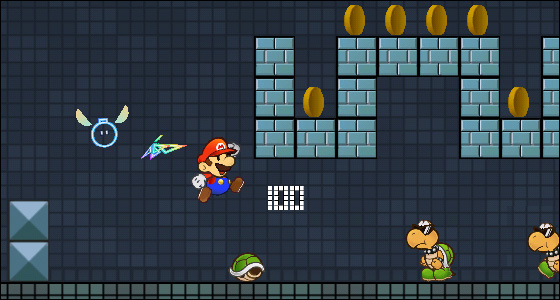
Super Paper Mario is actually a pretty sophisticated game though, as in it has many parts. I mean, it’s got platforming in two different dimensions, party management, inventory, abilities and side quests—that’s pretty wholesome right? It probably seems like quite the burden then, but isn’t. The trick is that Super Paper Mario manages to allude the player with the way its system is organised and presented. It does this in three ways: streamlining each “mode” of play to its fundamentals, clearly sectioning off different modes of play and only allowing the player to operate in a single mode at the one time. Let’s take a quick look at these different modes of play individually to see how they achieve this desired effect.
Platforming
The most obvious example would be the platforming. Both the 2D and 3D platforming are relatively simple. Although the platforming is practically lifted straight from the original Super Mario Bros., the difficult never reaches anything beyond, say, level 3-1 in the original game. Enemies only take little damage from your health bar, bottomless pits are few and never wide enough to stop you in your tracks. Mario and company can’t even build up much momentum. Only the brothers can gain enough to leap one block higher which isn’t saying terribly much. The platforming is simple and doesn’t require too much attention, it basically works as the medium for everything else (the exploration, mild combat and puzzling) to operate in.
There are two modes of play here, the 2D and the 3D platforming, and the only difference between them both is the change in perspective which in turn covers and hides different parts of the stage. Flipping, as the game calls it, is done frequently but only requires a simple press of the ‘A’ button and occurs almost instantaneously. The player doesn’t need to learn any additional techniques to operate in either dimension. Players only play in one dimension at a time and Mario is the only character who can switch dimensions.
Party Management, Abilities and Inventory
Another example would be the inventory, abilities and party management systems. Collectively these systems are quite complicated, but individually they’re rather simple.
Party
The player takes on 4 different party members each with a handful of specific properties. For instance: Bowser takes less damage, can deal more damage, is a slower walker, is larger and more difficult to more around in tight areas and can breath fire. This might seem complex but actually each character fits a gameplay archetype. Mario for platforming, Bowser for offensive attacks, Peach for long distance travel and Luigi for vertical jumps. It’s often very clear which character is suitable for which situation. Considering Mario has the ‘flip’ ability, players will use him for the majority of the game.
Abilities (Pixls)
Over the journey the player acquires 8 different pixls each with their own ability such as turning into a bomb, platform or hammer. Again, very simple, each one has just a single function.
Inventory
A series of items which can heal, take damage, add properties to party members and be traded and used in sub-games. The player has a tight limit on the number of items they can carry at the one time.
As with the dimension swapping, these systems are cleanly packed away from other parts of the game. For general use the player will access these three systems through the quick-use menu, a horizontal drop down menu which allows selections to be made on the fly. Whereas ‘A’ was used to switched between the binary 2D or 3D selections, the quick-use menu actually houses three different “modes”. To enter the quick launch the player must pause the game, cleanly separating these modes from the others.
Side Quest Options
Lastly there are side quest items such as cards, recipes and maps which are presented vertically on the menu screen. These cannot be reached via the quick-use menu, separating themselves from the rest.
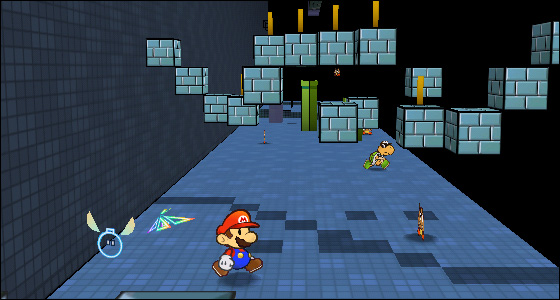
Conclusion
As we can see, Super Paper Mario is collectively a rather sophisticated game which features two flavours of platforming, party management, a series of abilities and plenty of side quests. Yet at the same time each part is streamlined to it’s minimalist, and separated from the other modes of play by menus and buttons configuration. The player is only concerned about a small number of variables at a single time, often being the lite platforming, respective pixl equipped and the character they have chosen (more often than not Mario). Considering that the game is never designed to have the player frequently swapping out their characters, using items or switching pixls, the core part of play revolves around the platforming with moderate use of other aids for exploration. It’s very straightforward, and compacts it’s complexity, unpacking itself where needed. This makes playing Super Paper Mario very light weight and burden-less as the gameplay is presented in a way that never feels any more complicated than a simple platform game. In actuality though the player often resorts to peripheral mechanics, co-ordinating the different systems together to reach a desired outcome.
Next up: How Super Paper Mario Feels Gamey
Additional Readings
Super Paper Mario Interview – Gametrailers
Metroid Prime 3: Quarterly Diaries #7
October 15th, 2009

Areas Covered: Imperial Caverns, GFS Valhalla, Skytram East, Sky Town
Discussion Points: Scrambled radio message and the random detour to GFS Valhalla, Skytram East’s level design, Phazon Metroid initial set piece
Imperial Caverns
Imperial Caverns has a beautiful calmness to it that really reflects on the area’s seclusion from the rest of the planet as well as the player’s quietening journey deeper into the environment. At about the most ambient point in the journey, a scrambled radio signal bursts out of your speaker—scaring the living daylights out of you and totally breaking the mood. Like all radio chatter it’s played over gameplay so it totally creeps up on the player.
Back in Bryyo you find out that it was the always intrusive Galactic Federation. Supposedly they lost your connection because of the warp point. In worried exasperation the respective Aurora Unit explains the reasons for static before pointing Samus to the abandoned GFS Valhalla. Another spot will open on the galaxy map, so away we go.
GFS Valhalla
GFS Valhalla was overrun by the space pirates and sits in a desolate sphere of space as a lonesome carrier for renegade pirates and other creatures. The visual tone of the area is typically brooding with a slick dark black and rich red aesthetic. The handful of enemy creatures still around put up an admittedly tough challenge, really puts you on edge and gives the atmosphere a sharp taste.
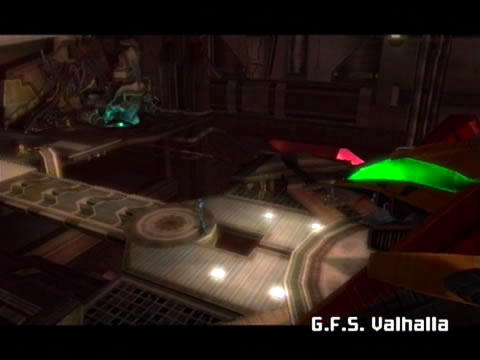
I have no idea why we were sent here though. The explanation put forward on Bryyo was simply that the place warranted investigation yet the abandoned wreck at this stage in the game has no use. After some quick exploration you’ll realize that you need four or five energy cells to re-power the station, but we don’t have the energy cells, and in fact won’t acquire any until the next area of the game! I can’t find the justification for sending you out here, particularly when the player already has an idea regarding the next point of passage (screw attack pads in Sky Town). The whole sequence, including the radio static, feels preempt, misplaced and unecessary—a red herring?
Skytram East
After screw-attacking your way up to the rather funky sky tram (everything in this area is so elegantly designed!), you arrive at the next portion of Elysia. The level design of this area is tightly interwoven and if you become too analytical (like me!) it’ll probably become confusing. The trick is to just follow your senses though, it’s all very straightforward.
Essentially, this area houses a series of bomb parts which will later be assembled and then dropped on the leviathan shield which’ll open up access to Elysia’s seed ie. the boss for this area. The player requires three things from this area: the ‘ship grapple’ upgrade (to lift the various components) and the first two individual bomb components. Acquiring the upgrade is obviously your first priority and to do that the player simply needs to make a linear trek to the opposite side of the map. The linear swing around the right-hand side works to introduce the general layout of the area, which is quite necessary given that the clump of floors in and around the three main centres can be particularly daunting. On the first romp not everything is accessible yet, which compartmentalizes your route nicely to lower areas of the map and keeps everything manageable, while at the same time teasing the unreachable areas. There’s a lot of smart layering in this section as the ship upgrade and seeker missiles manage the flow of access.
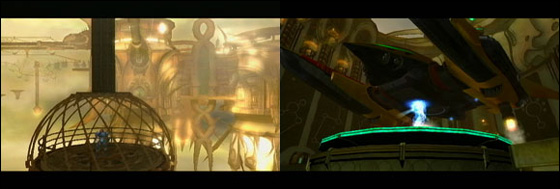
Once you reach the end and power-up your ship, the two components can be obtained in order of closest to furthest out from the end point; the design folds, accommodating the route reversal. Unfortunately the triangular, three-point design may mislead players to take the wrong route, but if you abide by the closest-to-furthest principle the design won’t pose any problems.
The ship grapple is used initially to lift a projector (large, circular mass) in the Chozo Observatory, doing so reveals a faulty circuit. Fix the circuit, drop the projector back in place and you’re given access to the upper floors. Eventually the upper route will overlap some with the route you originally took on the way in, concluding at the Concourse centre. Again we see Retro organically making clever use of the level design by interlocking different sections and having them feed into one another. I discussed this to death in the previous article, it’s prevalent throughout the series and a great design philosophy as it gives new purpose to borrowed material and allows the area to be exploited entirely by the player. In this case, by concluding at the Concourse centre the player has travelled in full circle and now has a thorough understanding of the environment. It’s makes play meaningful and this matters.
As for the room-by-room design, I think the three hub areas (centres) and the multiple floors and corridors which immediately stream off these areas are most interesting because they encompass a visual and structural design which feels very unified. This helps the level design too feel structured and organised, even though it’s all rather elaborate and could be entirely unwieldy.
Stepping back for a moment, there’s an offshoot area before the 2nd bomb component which leads to a Metroid research laboratory. This is the first time we’ve seen the nasty face rippers in Metroid Prime 3—and there’s a great sense of tension that builds up as you walk past the glass tubes of Phazon Metroids, a breed new to the series. You worm your way into the depths of this laboratory in search of the seeker missiles knowing all too well that soon these Metroids will break loose and trap you inside.* You know that the game is leading you down the garden path and it’s a real tension builder. The music is set perfectly and the transparent panels are good at making you feel cased into this danger zone, where the danger itself is highly visible.

On reaching the end point, Samus must depower a shield to access the seeker missiles. Doing so will switch off the security measures and free the Metroid’s from their cylindric cages. I guess you gotta compromise, so you grab the seeker missiles and leave. The lights are out and only the surrounding alien hues provide sufficient light. The transparent flooring highlights trails of Phazon Metroids rushing their way to flank you at the exit. You literally see them scurry under the floor beneath you. There’s a wonderful feeling of dread and tension in the air. I rather enjoyed this moment, it has a typically implicit way of communicating meaning to the player which is very much traditionalist Metroid.
*You know so because Retro drop subtle clues which the player may or may not gather, and this is why I have so much respect for Retro Studios. Other developers in this industry would at this point hold up a huge sign saying “AND NOW WE’RE SETTING UP AN UBER COOL SET PIECE, I HOPE YOU’RE READY, IT’S GONNA BE AWESOME, BY THE WAY I’M THE GAME DESIGNER”. Metroid is and will always be a mature and engrossing experience simply because it respects the player by assuming that they can actually think for themselves. The developers don’t need to connect the dots or pre-boast about a forthcoming event with pretension that demeans the player. I admire games that do this and I hope to talk about it a little more in future writing.
Sky Town
After obtaining the second bomb component, the ship heads off to send supplies elsewhere and you make your way back to the Sky Town for the last part which is located in the Transit hub which we spotted on the way in. The component is locked in place and requires the seeker missiles to break from its lock. Now we have all of the upgrades for this area, bar the spider ball which we don’t get until later.
Additional Readings
Metroid Prime 3 Wikitroid Entry
Metroid Prime 3: Quarterly Diaries #6
October 12th, 2009

As of this post I’m live, writing as I play, which’ll likely mean that after the next two posts I’ll hit a stump. Let’s see how far I can ride this train. Toot! Toot!
Areas Covered: Elysia (Main Docking Bay), Bryyo (Revisited 2nd), Imperial Caverns
Discussion Points: Backtracking, Tutorializing backtracking, Ghor battle, suit design, Imperial Caverns’ cyclic level design, Imperial Caverns and Phendrana Drifts
Elysia (Main Docking Bay)
As I moaned about for far too long in the Bryyo portion of my walk-through, backtracking is a chief concern of mine. Thankfully Retro have cut out a lot of backtracking (or at least removed the boredom out of it) for the next few sequences in the game. This’ll be the key point of discussion for the next stretch, so pay attention!
The trek back to your ship in pursuit of Ghor is treated as part of the continual training of the boost ball technique. The boost ball is required in generating power for the cannons which shorten your route back to the ship. The re-routing gives the environment a bit of zest, as is usually the case for good backtracking. Furthermore, as you probably noticed on your way in, there is a series of half pipes and other devices which each require the boost ball. These devices all aid in rejuvenating the path back to your ship as well as familiarizing you with the various applications of the boost ball technique.
I suppose I ought to talk about the fight with Ghor now, but I honestly don’t feel like discussing it. I can’t say that it was another regurgitation of the oft-repeated outer shell, inner core design, but simply put, the battle just felt stale and unresponsive. To make matters worse, Ghor’s clunky armor is an eyesore to look at. Another assurance that almost all of the boss battles up to this point have been a sour-y letdown. On the flip-side the plasma beam is awesome. ^_^

The plasma beam will probably trigger off a pulse in your brain reminding you of all those ice blockages throughout Bryyo. It’s a pity then that the ship is damaged and in a self-healing mode, meaning one thing: back to the Aurora Unit! It’s another retread, however Retro have twice managed to avoid the grind of repetition by again pinching from page 251 in the rule book of Nintendo game design which states “new abilities equals new ways of subverting troublesome backtracking”. This time the plasma beam can clear rubble lying around cannons, ziplining back to your destination. Again, backtracking becomes a tutorial. The cannons integrate well in the open environment and allow for new routes to be mapped onto the existing path structure.
I love Nintendo games, they all utilize the same shared set of common-sense design principles. Did you take note of the block-the-exit-with-obstacle-that-requires-the-new-ability trick after the Ghor battle? You should have, they’ve been pulling that one forever.
Anyways, after using the plasma beam in a series of welding exercises, the Aurora Unit will blabber some nonsense about leviathans, shields and some over-sized components. I really like Samus’ powerful stance and the angle which frames her in this sequence. There’s something visually attractive about the subdued colours and exoskeleton frame of Samus’ suit. She’s not quite human nor does she bear much resemblance to a space marine. Something about the design commands respect and I can’t quite put my finger on it. Flag this idea for another article.

With obligations aside you can go back to Bryyo and unearth whatever’s behind the frozen blockages. On the way you’ll stumble upon the green wall panels in Sky Town. The Aurora Unit will alert you that the required upgrade (screw attack) is available on Bryyo. Planting a seed and foreshadowing the next interval of gameplay. Another neat trick.
Bryyo (Revisited 2nd)
Heading back to Bryyo resurrects some old dilemmas: which airdock do you stop off at? Both places have uses for the plasma beam, which choice is the right one; the one with the screw attack? Fortunately making the wrong decision won’t punish you. Firey Airdock progresses the story while Cliffside Airdock sends you on an impressive upgrade trail which spirals around previous areas in a stupefying fashion. Damn. Retro are pulling out all the stops when it comes to addressing my previous complaints!
The same tutorial/backtracking trick is still in operation on your way back through Bryyo. It doesn’t take long before you find a warp which’ll take you to Imperial Caverns. A warp? Ok, this seems a little strange (why not just connect the two areas?), but I swear it’s happened before in a Metroid game. Oh yeah, Metroid Prime 2, light-dark world portals.
Imperial Caverns
Players of the original Metroid Prime will likely feel sentimental towards Imperial Caverns. It’s a visual copy and paste of the much adored Phendrana Drifts. Sadly the assets appear to be ripped straight from 2002 with no considerable servicing to speak of. It’s unfortunate as it dampens much of the charm and makes everything feel a little old.
Imperial Caverns only houses the screw attack upgrade and not much else, giving it a relatively minor and, considering it’s connection to the rest of the planet, obscure presence in the scope of things.
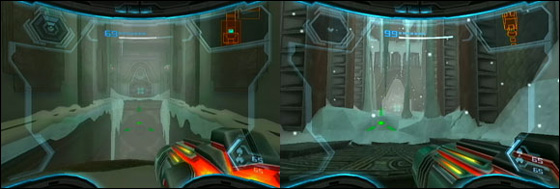
I really dig the cyclic level design of this area, it clearly communicates to the player that they’ve traversed in a loop by structurally designing the caverns in series of circular shapes. Much of Metroid’s level design operates in a loop fashion; you enter an area, acquire a weapon and then loop your way to your initial starting point. It’s just in this area the structural design paints an appreciable representation. The verticality helps too, not sure that I’m in favour of smashing the floors of ice though.
Side note: I figured out my problems with the Sky Town map. Basically the different floors are connect to the exterior hub. Sometimes the ground floor will connect to a centre point which then sends you to the first floor of another area. When looking at it from above (as the map is presented) it’s difficult to determine which floors contain the appropriate exits. That is, unless you zoom in right up close, but that becomes a hassle into itself.
Another random aside: I just figured out why the ice missiles have the ice property. Freezing make-shift platforms is a compulsory part of your repertoire, by assigning ice properties to the missiles there can be no conflict from the regular beam. Incidentally the regular (plasma) beam achieves the opposite purpose by melting ice and is in the same way assigned.
Additional Readings
Nintendo’s Video Game Masterpiece – ABC News



 Game Design Companion: A Critical Analysis of Wario Land 4 - $7.99
Game Design Companion: A Critical Analysis of Wario Land 4 - $7.99 Level Design: Processes and Experiences
Level Design: Processes and Experiences Speed Boost: The Hidden Secrets Behind Arcade Racing Design - $5.99
Speed Boost: The Hidden Secrets Behind Arcade Racing Design - $5.99 Adventures in Games Analysis: Volume I - $5.99
Adventures in Games Analysis: Volume I - $5.99







